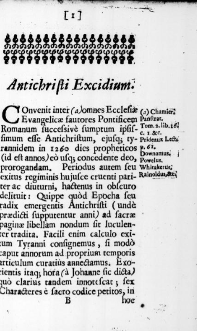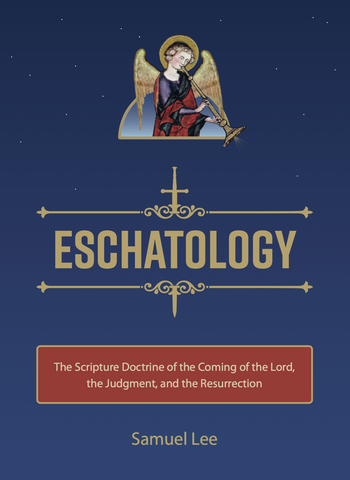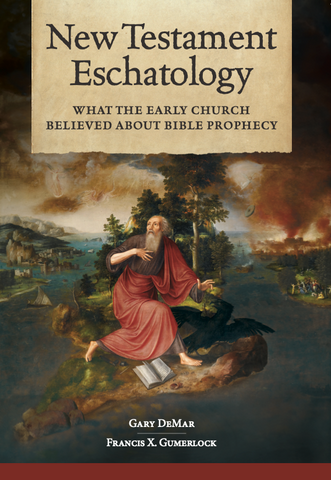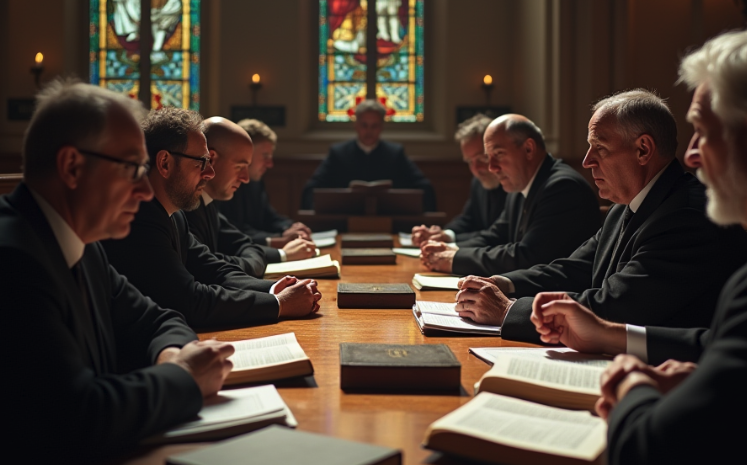Important Note: Gary DeMar’s Facebook page has been taken down. To keep up with the latest from Gary and American Vision or to continue the conversation from articles, podcasts, or videos, please go to the AV Facebook page here.
Ken Gentry mentioned me again on his postmil website. It’s the same old story with Ken refusing to pay attention to the arguments I’ve made in the past regarding the Three Questions Letter. It’s getting old, but it gives me the opportunity to focus on the points I’ve made in the past. I’m still looking for the verse or verses that the letter signers agree on that unequivocally refer to Jesus’ future physical coming. It seems like a simple request.
Gentry’s problem is that he is inconsistent in his own position as numerous people as well as I have pointed out. Dispensational writer and author of a two-volume work on Revelation Robert Thomas noted the problem in his 1994 review of Gentry’s Before Jerusalem Fell.
How is it that the cloud-coming of A.D. 70 involves no personal coming of Christ (Matt. 24:30; 26:64; Rev. 1:7; 2:5, 16, 25; 3:3, 11, 20; 16:15; 22:7, 12, 20), but the cloud coming at the end of history does (Acts 1:11; 1 Thess. 4:13ff.)? In the first place, where did Christ distinguish between two comings, and in the second place, where did He say that He would personally appear at one and not the other? The answer to both questions is “nowhere.”[1]
It’s not often I agree with a dispensationalist, but Thomas is spot on in his critique. Thomas has his own interpretive problems, but on this point, he brought the issue into clear focus. Gentry is safe among his supporters and friends who have the same interpretive problem, but not among those who have scrutinized his work.
Have you noticed that when Sola Scriptura is brought up in a debate over theological views that man-made creeds and extensive confessional statements seem to interpret Scripture for us? What did Christians do before Nicaea (325) and the assembly of Westminster ‘Divines’ from 1643 to 1653 were framed and published? Sola Scriptura or Solo Scriptura? The original WCF declared, “the Pope of Rome … is that Antichrist, that man of sin, and son of perdition, that exalts himself, in the Church, against Christ and all that is called God. (WCF 25.6) This was later changed even though nearly all the Reformers argued the Papacy was the antichrist.[2] Samuel Lee (1625-1691, not the Lee mentioned below), in his 1664 work Antichristi Excidium (The Cutting Off of Antichrist), maintained, “It is agreed among all maintainers of the Evangelical Church that the Roman Pontiff is Antichrist.”[3]

Gentry is going against the Evangelical Church—“agreed among all”—because he does not hold to the nearly unanimous Reformation view and the original authors of the Westminster Confession of Faith that the Papacy was/is the antichrist. The historical argument cuts both ways. I know, Gentry will say but that’s not the case with the future physical coming of Jesus and dead bodies being reconstituted and raised when Jesus returns. Curiously, the Nicene does not say this will happen, and as far as I can see, the Bible does not specifically state such a belief in specific words It’s a matter of interpretation. This is not the case when the Apostles’ Creed says that Jesus was “born of the Virgin Mary.” There’s a verse for that.
The Nicene Creed states, “I believe in the resurrection of the dead.” I believe in the resurrection of the dead because that’s what the Bible says. Paul declared it.
• “‘I stand on trial because of the hope of the resurrection of the dead.’” (Acts 23:6)
• “‘For the resurrection of the dead I am on trial before you today.’” (Acts 24:21)
• “‘Why is it considered incredible among you if God does raise the dead?’” (Acts 26:6)
• “That by any means possible I may attain the resurrection from the dead.” (Phil. 3:11)
Why is “the resurrection of the dead” something Christians should believe? Because it’s in the Bible, just like the Bible says God is “the maker of heaven and earth,” Jesus “was incarnate … of the virgin Mary” and “was crucified also for us under Pontius Pilate” among other historical points stated, “according to the Scriptures.”
If the elders in the church I attend asked me, “Gary, do you believe in the resurrection of the dead,” I would emphatically say, “yes.” Why? Because that’s what the Bible says! Critics of preterist arguments play a game of Three-Card Monte when it comes to subscription to the creeds. Three-card monte is a confidence game in which players are challenged to bet on finding the “money card” among three face-down cards. The players always lose because the person moving the cards has rigged the game. Yes, it’s the creeds because the creeds reference Scripture, but it’s the historic church that defines what the Scriptures teach as long as what is taught comports with Scripture. Here’s an example from Kenneth Gentry:
This tragedy has arisen due to a very prideful error: the replacing of sola Scriptura (Scripture alone) with solo Scriptura (I alone am the interpreter of Scripture). “I know more than the church of all ages; I do not have to stand on the shoulders of giants.”
But who does Gentry cite to support his views? Individuals! A group of solos! Well, there are a lot of solos who are asking some very good questions. It’s not just one guy.
When does sola Scriptura become solo Scriptura? Jehovah’s Witnesses created their own Bible translation, The New World Translation, to manipulate Scripture to fit their new doctrines, and the Mormons added a plethora of new supposed inspired works to manufacture their new religion. These were solo cults. Those who questioned the interpretation of some prophetic texts that might challenge long-held beliefs followed sola Scriptura. No new translations or ecclesiastical hierarchies were created to manipulate the faithful. Their works are often unknown, ignored, or dismissed. They weren’t “semi-cultic” as Gentry derisively describes such efforts. See Samuel Lee’s 1859 book Eschatology for a rigorous exegetical study of the topic. The following is from his Preface.

Eschatology, or The Scripture Doctrine of the Coming of the Lord, the Judgment, and the Resurrection
Predictions about the end have a long and less than accurate history. What’s the reason? How could so many be so wrong for so many years? Why does prophetic speculation run rampant today given the excesses of failed predictions based on the claimed certainties of “thus say the Scriptures”? What’s lacking in so much of today’s scholarship is the willingness to let Scripture interpret Scripture even if the results may call for a refinement of long-held prophetic views.
Buy NowEarly in his ministry, the writer attempted to gain some definite views on the subject presented in this volume. He consulted authors, and especially commentators. The effect was “confusion worse confounded.” He then, as the only hope, went directly and alone to the volume of Inspiration, and attempted to study the Scriptures scripturally,—to make the Bible its own interpreter. The result is the opinions expressed in the following pages.
There was also Israel Warren who published The Parousia: A Critical Study of the Scripture Doctrines of Christ’s Second Coming, His Reign as King, the Resurrection of the Dead, and the General Judgment in 1879.
Protestants, at least, believe not only in the right but the duty of private judgment. While fully recognizing the claims of authority, and deferring, as is most proper, to the opinions of scholars, and especially to the statements of venerable creeds and formularies, I cannot forget that these have not, in fact, been infallible guides, but that notwithstanding them doubt, diversity, and distrust still envelope the whole field of eschatology. (iv)
I suggest that Gentry and other preterist critics like Steve Gregg, who wrote, Why Not Full-Preterism?: A Partial-Preterist Response to a Novel Theological Innovation (2022), respond to the works of Lee, Warren, and other preterist writers.
There were enough of these works that could not be dismissed as solo Scriptura. Let’s not forget that Gentry enthusiastically endorsed J. Stuart Russell’s The Parousia in his book Before Jerusalem Fell: Dating the Book of Revelation. Russell disagreed with Gentry in several places, for example, Acts 1:11 and 17:31, that Gentry unequivocally takes as Second Coming passages. Warren has an extended commentary on Acts 1:11 in his Parousia book (61-66). Warren interacts with other scholars. He’s not doing solo Scriptura.
Russell does futurize Revelation 20, but Gentry states, “John’s time frame demands a first-century context. The description of the new creation and new Jerusalem bride-city extends from Revelation 21:1 to 22:5…. But what of all the majestic expressions in Revelation 21-22? The preterist believes that John is expressing, by means of elevated poetic imagery, the glory of salvation.”[4] This means, according to Gentry, the thousand years are still going on, but Revelation 21-22 “demands a first century context” because of Revelation 22:6, 10, 12, 20. I’m assuming Gentry would have to say that they are in parallel. But this is confusing since he argues that the physical destruction of heaven and earth has not happened based on his interpretation of Matthew 24:36 and 2 Peter 3. It’s quite confusing, and many people have noticed.
Gentry criticizes me for not affirming these three questions:
(1) the future, bodily second coming of Christ, (2) the material, eternal, bodily resurrection of the dead, and (3) the final judgment of all men that ends history. These are the very issues a group of theological friends of Gary DeMar put to him, seeking a simple yes or no answer regarding whether or not he accepted them. He declined to answer with a yes or no.
Gentry and my supposed “theological friends” will search in vain to find these questions answered as either “yes” or “no” in the Nicene Creed. As I stated at the beginning of this article, I believe in the resurrection of the dead and Jesus coming again to judge the living and the dead.[5]

New Testament Eschatology
Since the futurist perspective has been promoted as an early church reality by so many for so long, few question it. New Testament Eschatology challenges this prevailing futurist view with a careful study of the historical record. The evidence shows that many early church writers understood the destruction of Jerusalem in AD 70 to be the end of the Old Covenant world.
Buy NowGentry would most likely respond, “the church has defined the creedal definitions for us, and we must assume they are correct. Any questions related to them is ‘a very prideful error.’”
Gentry needs to come clean on his Three-Card Monte diversion, for that’s what it is, and turn over all the cards and engage in a public exegetical debate based on Scripture alone. He can do this by getting with all my “theological friends” who signed the Three Questions Letter and agree on THE verse that unequivocally states that Jesus will return physically to raise long-dead decomposed bodies and reunite them with their souls. At the same time, he and my “theological friends” must show that the view of receiving new bodies at death, as Charles Hodge in volume 3 of his Systematic Theology (780) put it, “are in some high, true, and real sense, to be the same as those which we now have,” is heretical. The same result but sooner (at death) so that those with Christ are not “unclothed” (2 Cor. 5:4).
According to Gentry and my “theological friends,” investigating eschatology exegetically is forbidden so you don’t come to any new conclusions. The Protestant Popes have said so!
[1] Robert L. Thomas, “Theonomy and the Dating of Revelation,” The Master’s Seminary Journal, 5:2 (Fall 1994), 198.
[2] Ralph Woodrow, Great Prophecies of the Bible (1971), 182-195.
[3] See Le Roy Edwin Froom, The Prophetic Faith of our Fathers: The Historical Development of Prophetic Interpretation, 4 vols. (Washington, D.C.: Review and Herald, 1946), 3:112.
[4] Gentry, “A Preterist View of Revelation,” Four Views on the Book of Revelation, ed. C. Marvin Pate (Grand Rapids, Kregel, 1998), 87.
[5] See Chapter 11 in my book with Francis X. Gumerlock, New Testament Eschatology: What the Early Church Believed About Bible Prophecy (Powder Springs, GA: American Vision, 2024), chap. 11.

